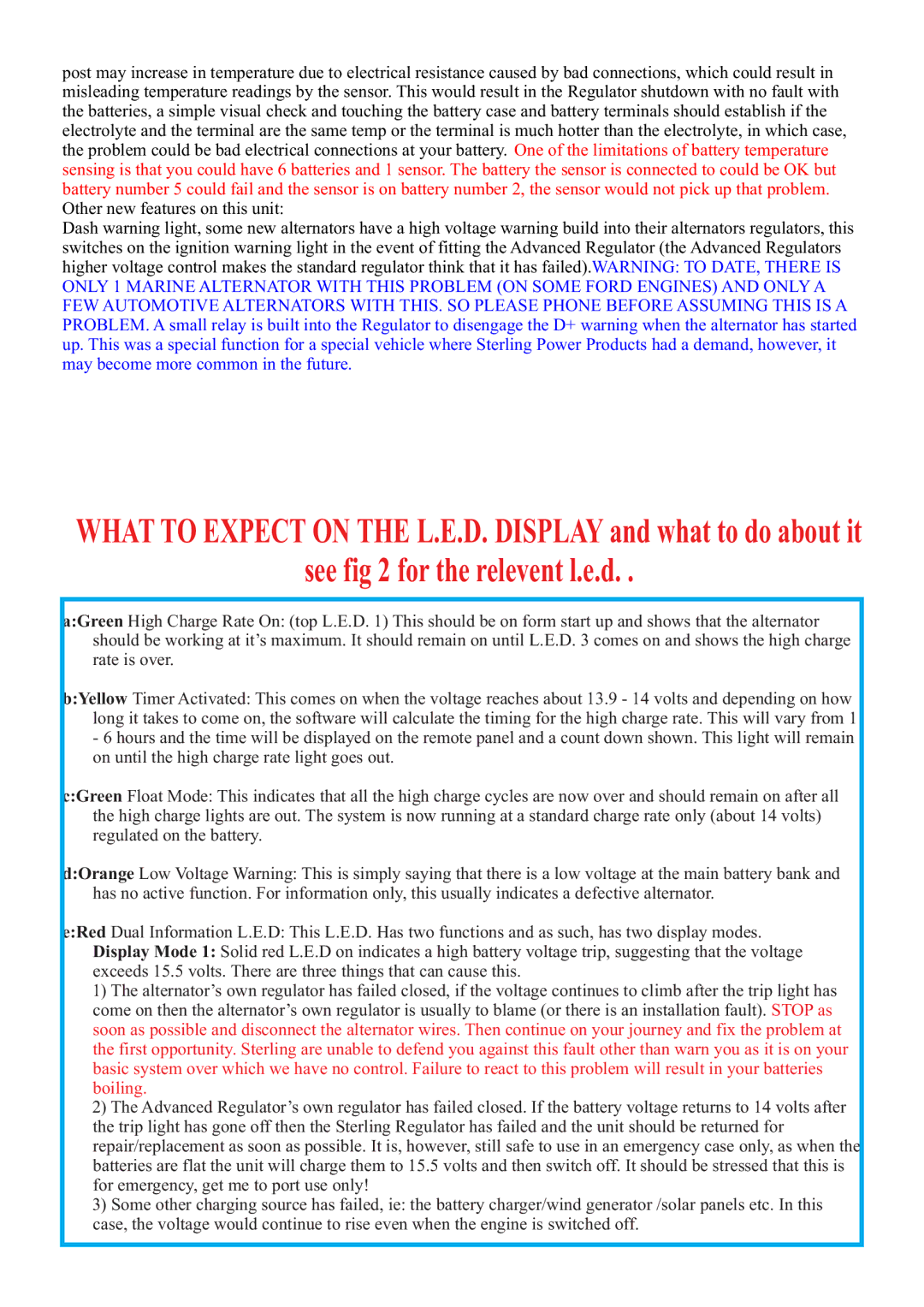
post may increase in temperature due to electrical resistance caused by bad connections, which could result in misleading temperature readings by the sensor. This would result in the Regulator shutdown with no fault with the batteries, a simple visual check and touching the battery case and battery terminals should establish if the electrolyte and the terminal are the same temp or the terminal is much hotter than the electrolyte, in which case, the problem could be bad electrical connections at your battery. One of the limitations of battery temperature sensing is that you could have 6 batteries and 1 sensor. The battery the sensor is connected to could be OK but battery number 5 could fail and the sensor is on battery number 2, the sensor would not pick up that problem. Other new features on this unit:
Dash warning light, some new alternators have a high voltage warning build into their alternators regulators, this switches on the ignition warning light in the event of fitting the Advanced Regulator (the Advanced Regulators higher voltage control makes the standard regulator think that it has failed).WARNING: TO DATE, THERE IS ONLY 1 MARINE ALTERNATOR WITH THIS PROBLEM (ON SOME FORD ENGINES) AND ONLY A FEW AUTOMOTIVE ALTERNATORS WITH THIS. SO PLEASE PHONE BEFORE ASSUMING THIS IS A PROBLEM. A small relay is built into the Regulator to disengage the D+ warning when the alternator has started up. This was a special function for a special vehicle where Sterling Power Products had a demand, however, it may become more common in the future.
WHAT TO EXPECT ON THE L.E.D. DISPLAY and what to do about it
see fig 2 for the relevent l.e.d. .
a:Green High Charge Rate On: (top L.E.D. 1) This should be on form start up and shows that the alternator should be working at it’s maximum. It should remain on until L.E.D. 3 comes on and shows the high charge rate is over.
b:Yellow Timer Activated: This comes on when the voltage reaches about 13.9 - 14 volts and depending on how long it takes to come on, the software will calculate the timing for the high charge rate. This will vary from 1
-6 hours and the time will be displayed on the remote panel and a count down shown. This light will remain on until the high charge rate light goes out.
c:Green Float Mode: This indicates that all the high charge cycles are now over and should remain on after all the high charge lights are out. The system is now running at a standard charge rate only (about 14 volts) regulated on the battery.
d:Orange Low Voltage Warning: This is simply saying that there is a low voltage at the main battery bank and has no active function. For information only, this usually indicates a defective alternator.
e:Red Dual Information L.E.D: This L.E.D. Has two functions and as such, has two display modes. Display Mode 1: Solid red L.E.D on indicates a high battery voltage trip, suggesting that the voltage exceeds 15.5 volts. There are three things that can cause this.
1)The alternator’s own regulator has failed closed, if the voltage continues to climb after the trip light has come on then the alternator’s own regulator is usually to blame (or there is an installation fault). STOP as soon as possible and disconnect the alternator wires. Then continue on your journey and fix the problem at the first opportunity. Sterling are unable to defend you against this fault other than warn you as it is on your basic system over which we have no control. Failure to react to this problem will result in your batteries boiling.
2)The Advanced Regulator’s own regulator has failed closed. If the battery voltage returns to 14 volts after the trip light has gone off then the Sterling Regulator has failed and the unit should be returned for repair/replacement as soon as possible. It is, however, still safe to use in an emergency case only, as when the batteries are flat the unit will charge them to 15.5 volts and then switch off. It should be stressed that this is for emergency, get me to port use only!
3)Some other charging source has failed, ie: the battery charger/wind generator /solar panels etc. In this case, the voltage would continue to rise even when the engine is switched off.
